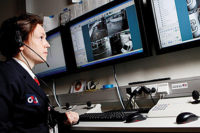
The use of wireless technologies in security systems is at a tipping point of sorts that many agree will lead to explosive growth in the months and years to come. Among the driving factors are more IT-savvy end-users, new technologies that increase network bandwidth and the uncertainty of the future of POTS for alarm communications.
Niall Jenkins, a senior research analyst with IMS Research in Wellingborough, U.K., recently published a report titled “The America’s Market for Wireless Infrastructure Used in Video Surveillance.” He says that while the use of wireless for security systems makes up only a small percentage of total installations, the future looks bright. Chief among the opportunities, he says, is transmitting video over wireless.
“Despite its successes, the penetration of wireless networking into the total video surveillance market remains relatively low,” he says. “There is still great potential to increase this penetration over the next five to 10 years.”
The industry already seems to have taken notice of the potential for video over wireless. Tim Streuber, vice president of wireless security for Aurora, Ill.-based WAV, says video makes up a good portion of the projects his technical services team designs and installs, particularly in outdoor installations.
“Wireless for video and security is growing all the time,” he says. “Outdoor wireless has changed a lot. It used to be mainly for wireless ISPs. There’s still a lot of that, but it’s not as strong as it used to be.”
WHAT'S YOUR FLAVOR?
Before delving into the challenges and opportunities wireless presents, it’s important to begin at the beginning. In other words, just what is a wireless network and how does it work?
There are three main types of wireless networks for linking a remote point to a wired network: point-to-point (PTP), point-to-multipoint (PTMP) and mesh networks.
PTP is the simplest configuration of a wireless link, involving communication between only two points. An example would be a camera installed on a single light pole in a parking lot. The radio attached to that camera sends a signal to the transceiver (head-end) located at the building. That head-end then feeds the signal into the wired network. Put cameras on five light poles and you’ll have a PTMP link.
A mesh network is much more complicated. It consists of multiple points called nodes, each of which transmits and receives data from neighboring nodes and passes it along the network to the head-end.
These “hops” from node to node allow a wireless network to extend to a greater distance, while providing coverage that is more like the blanket coverage we’ve come to expect from Wi-Fi. Based on this increased reliability and coverage, as well as the ability to be deployed in mobile applications such as mass transit, mesh networks are garnering a lot of interest in the industry, says Tom Kenty, general sales manager for Peabody, Mass.-based AES-IntelliNet.
Provided that each node has line of sight to the next or to the head-end, “we’re only limited by the curve of the earth,” Streuber says. In theory that’s true, he adds, stressing that too many hops on a mesh network create video latency. For example, after seven to 10 hops, video becomes jittery and pixelated. Ideally, Streuber says, a mesh network should “take the shortest path to the head-end with the least amount of hops.” In reality, WAV has installed a mesh network that extends 39 miles.
“With tall towers at both ends, you can go a long way with the equipment,” he says.
POTENTIAL APPLICATIONS
The most common applications for wireless networks include borders, boundaries, large campuses and remote locations. But, says Ksenia Coffman, senior marketing manager for FireTide in Los Gatos, Calif., the possibilities don’t start and end with these. “Anywhere there’s an outdoor setting without an existing infrastructure, you should be considering and proposing wireless,” she believes.
Arlene Custock, president of PAC Integrations in Concorde, Calif., says it can be deployed in virtually all situations. “Signal limitations are about the only challenge, and the use of creativity to overcome that is the only limitation,” she says.
Valley Ag Software in Tullare, Calif., started in providing wireless security for agricultural applications. While that’s still a core focus, the company has seen a demand for government applications, notes Sean Woods, IT manager. “In a lot of places, there’s no way to get all-over coverage without wireless,” he says. “You can’t exactly go in and dig trenches for a wired system in a prison.”
Through his research, Jenkins at IMS Research found that municipal surveillance has been the most common application for a simple reason: cost. “A key benefit of using a wireless network is the cost savings associated with not trenching to lay cable or fiber,” he says. “In municipal surveillance projects, cameras can be located over large areas and the cost of trenching these distances can be high.”
Jenkins adds that transportation and commercial sectors have also been popular uses of wireless, especially when cameras must be installed in areas where a wired network would be difficult "not to mention expensive" to install.
DIFFICULTY
Before you start proposing wireless to new and existing customers, it’s important to know about the skills and knowledge it takes to install a robust and reliable network.
Woods says the proliferation of wireless, notably the seemingly ubiquitous wireless Internet access, is both a blessing and a curse. The upside is that customers now see the potential of wireless in security systems. The downside is that the wireless used in security systems is much more complex than your average wireless router.
“The ease of installing a home access point is misleading because it makes wireless seem like it’s plug-and-play,” Woods says. “The truth is that wireless is not as easy as everyone would like it to be, especially when it involves adding a large chunk of data to your wired network.”
Because it’s the foundation for all things IP, Woods says the wired network is the most important part of designing a system. From an IT perspective, everything attached to that network, whether a printer, a computer or a camera, is just a piece of hardware. The goal is to ensure that that network can accommodate it. So if the main network is designed well, everything else just falls into place.
While some companies have made products that are easier (or less difficult) to install, interfacing with the network is where many installers and integrators, particularly those who have done the same thing the same way for years, encounter the greatest challenge, Woods believes.
“Security is a beast of its own, and IP has added another whole beast layer on top of that,” he describes. “It takes someone very well-versed in wireless, doubly so for video surveillance where there’s no room for error.”
Streuber, whose company provides design services and support to integrators, compares the growth of wireless in the industry to the growth of IP. “The vast majority of installers are old-school, so they’re relative newcomers to the world of IP to begin with,” he says.
Having designed wireless systems for years, well before there were integrated solutions on the market, it’s no wonder Custock has a slightly different take on the difficulty of installing today’s wireless networks. “With the right tools and experience, wireless can be very simple to install,” she says. “But if you’ve been working in a more traditional vein for a long time and haven’t dipped into the water or done it before, it can certainly be intimidating.”
HELP IS OUT THERE
If wireless seems intimidating to you, you’re not alone. In interviews with systems integrators, Jenkins found the majority had limited knowledge of wireless and relied heavily on manufacturers’ support. Fortunately, training and assistance are readily available. Solutions range from basic installation safety practices to intensive hands-on training.
Manufacturers also offer on-site professional services and technical assistance to help integrators navigate their way through the wireless world. For example, WAV offers to consult with integrators on basic design and a bill of materials to help them bid jobs at no cost to the integrator.
Inovonics’ technical services group provides what Mark Jarman, president of Louisville, Colo.-based Inovonics, calls more of a problem-solving service, which he says often ends up being on-site training. “With training, it’s easy to come up with the right skills,” he says.
That’s also FireTide’s approach, Coffman says. Whether learning in a classroom through a three-day hands-on wireless certification course or learning on the job by working with FireTide’s professional services group, integrators come away prepared to design and install wireless networks on their own.
OBSTACLES
Most, if not all, obstacles installers may encounter with designing and deploying a wireless network can be overcome or avoided altogether.
“One of the most common mistakes is skipping a site survey, which almost always leads to performance issues,” Coffman says. “A good survey has to be much more involved than simply using Google Maps or a basic walk-through.”
Line of sight is the most important consideration, says Cosimo Malesci, vice president of channel sales for Boston-based Fluidmesh. “Without it, the system won’t work. It’s not enough to say, ‘I think I have line of sight,’” he emphasizes.
Wireless frequencies are either licensed (requiring a fee) or unlicensed (free). Naturally, cost makes unlicensed networks more attractive. This could lead to interference from other networks, causing bandwidth issues and leading to slowed or delayed communication.
“You can’t control what’s around, but you can adjust your frequency based on the neighborhood,” Malesci says.
OPPORTUNITIES
Wireless is experiencing double-digit growth, and with new products making it easier to install wireless, that number is only going to increase over the next few years, Malesci believes. Therefore, avoiding wireless could be bad for business.
“Any security integrator who doesn’t embrace all the new technologies is going to end up on the short bus,” Woods says.
Fiber may be more familiar, but there are enough resources available in the marketplace that will build integrators’ comfort level with wireless. Remember that customers increasingly want wireless. Any integrator who can demonstrate an expertise in wireless will have a leg up in the bidding process.
“Customers expect their integrator to have the expertise to place a camera out there and just make it work,” Streuber emphasizes.
The best advice for understanding what a wireless system can really do, Malesci says, is to start small. “Get your feet wet with a simple point-to-point system,” he advises. “That will give you some idea of the technology, and you can grow from there.”
The Revenue Potential
Aside from the rapid growth in demand for wireless networks for security systems, another reason integrators may want to adopt wireless is the potential for continuing and future revenue, says Ksenia Coffman of Firetide.
For starters, systems need to be maintained, so there is an opportunity to schedule yearly network and system checkups. There also exists the possibility that customers will want to build on that wireless foundation you’ve laid, Coffman says.
“Wireless is often ongoing and can lead to further stages, whether that’s adding more cameras, more security systems or expanding the existing system,” she explains.
And based on Firetide’s history, that possibility is very high. “Our experience has been that three-quarters of projects go into second, third or fourth stages, sometimes more,” she relates.
The Frequency Highway
When designing and installing any wireless network, frequency is one of the most important considerations. With Wi-Fi and other technologies growing in popularity, the limited range of no-fee, unlicensed frequencies can get congested, causing interference.
“If you can put in something that uses unlicensed frequencies, that means the 16-year-old down the street who’s working on a science project can do that too,” says Tim Streuber of WAV. “And what he’s doing could step on your signal.”
So how crowded are those frequencies and how close are they to critical mass?
“Only so much frequency exists that won’t burn your eyeballs. We’re not there yet, but at some point down the road, frequency is going to be a big issue,” says Sean Woods of Valley Ag Software.
One solution is to use licensed frequencies, which require a fee, making them more expensive. Woods has a more creative solution that may or may not ever come to fruition, but that would open up a whole new world of possibility for wireless.
“The FCC (Federal Communications Commission) is quasi-auctioning off and trying to allocate the old TV bands, which are obsolete with everything going digital,” he says. “That’s non-line-of-sight stuff, which we don’t have in the security world, but it’s going to take a kinder, gentler FCC.”









